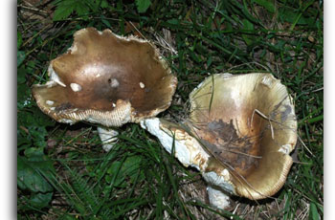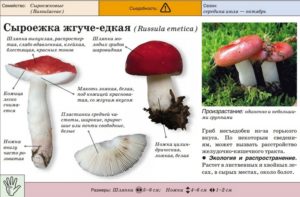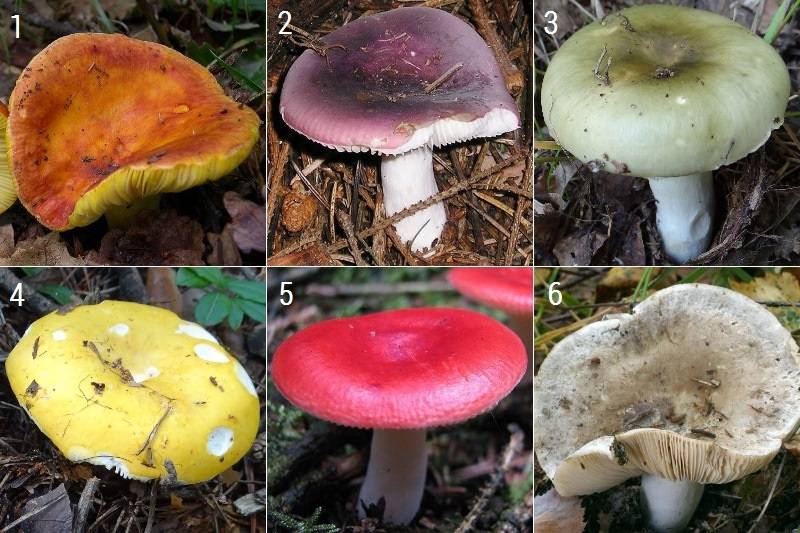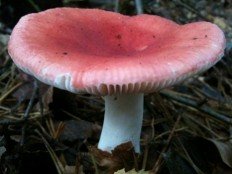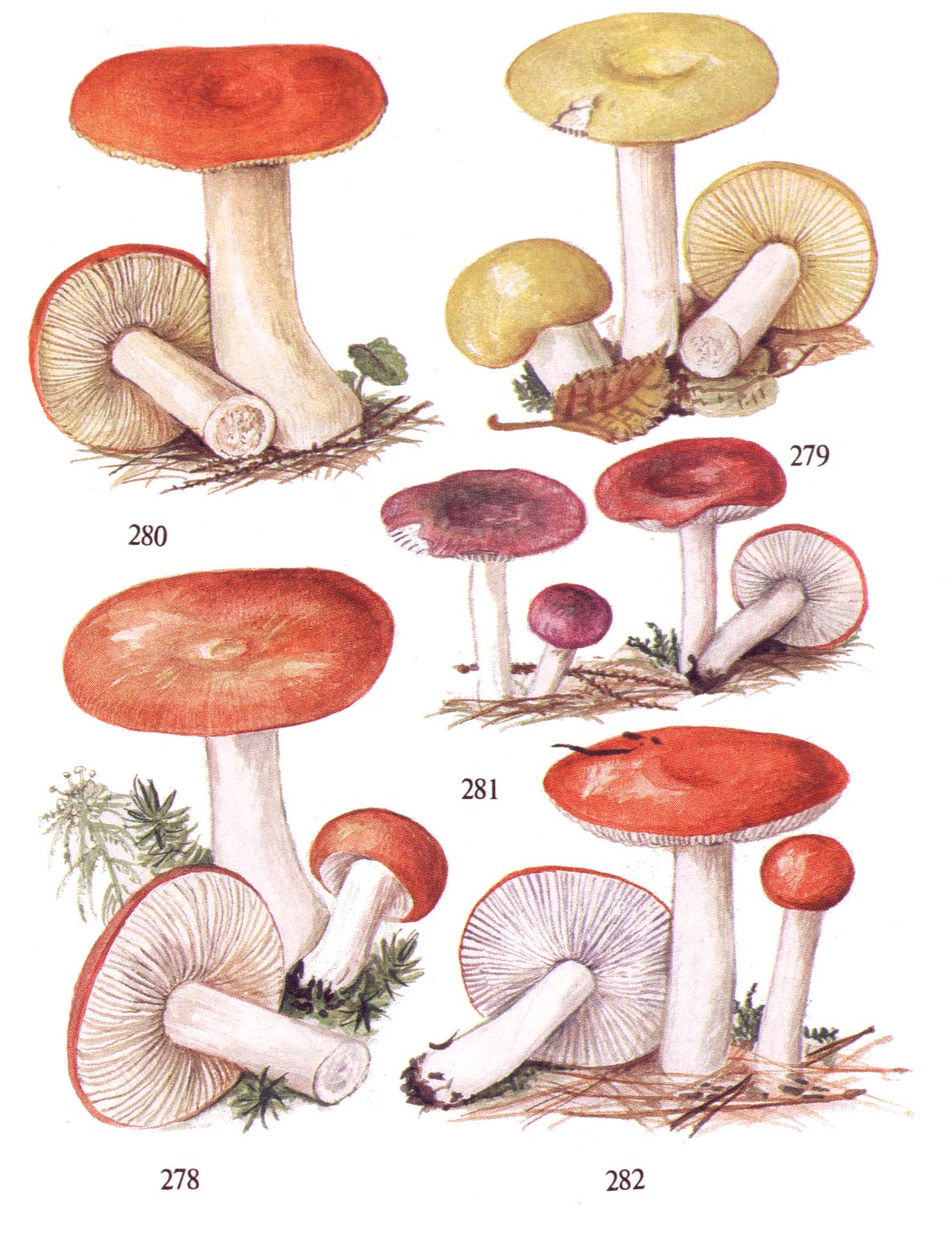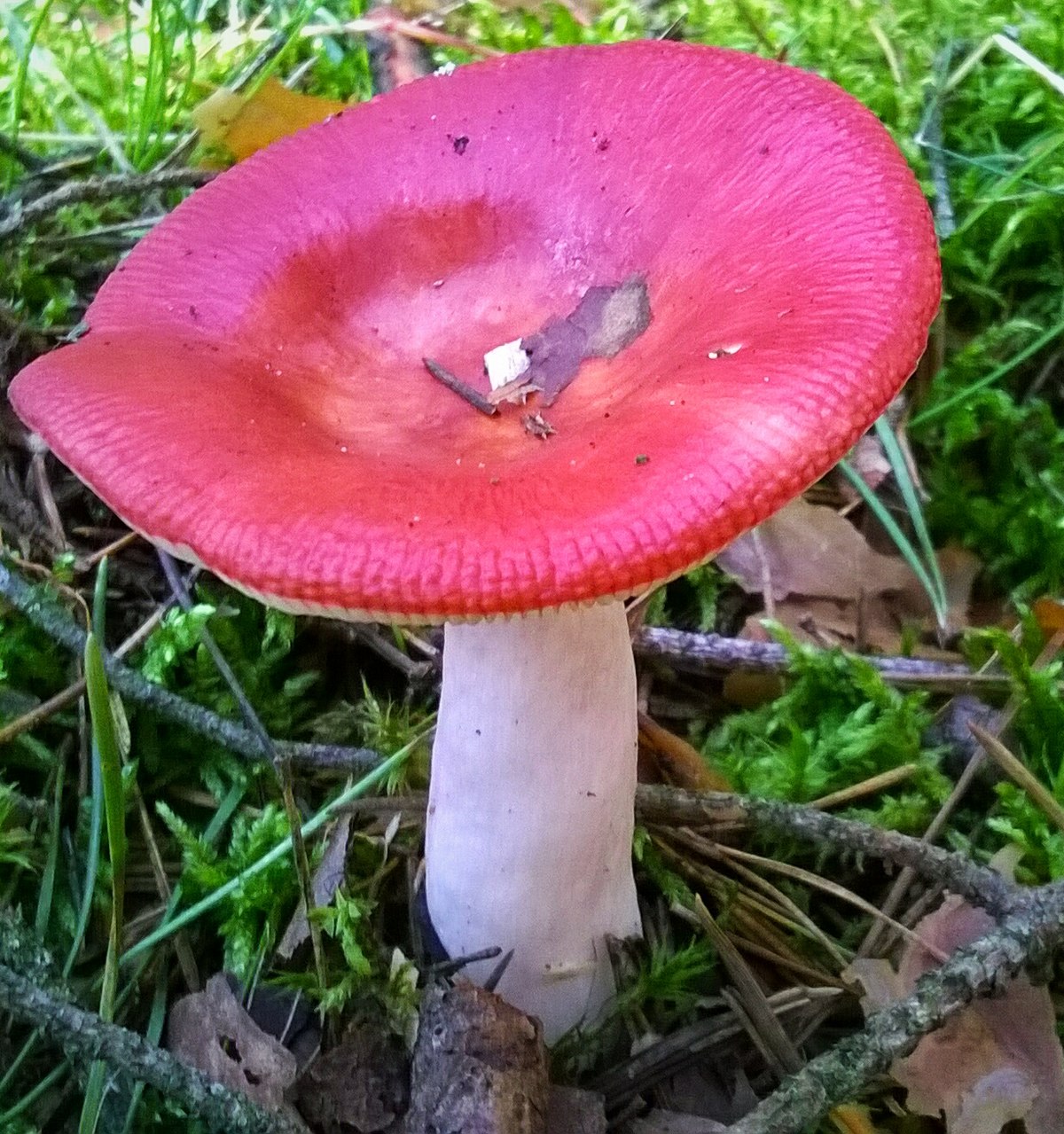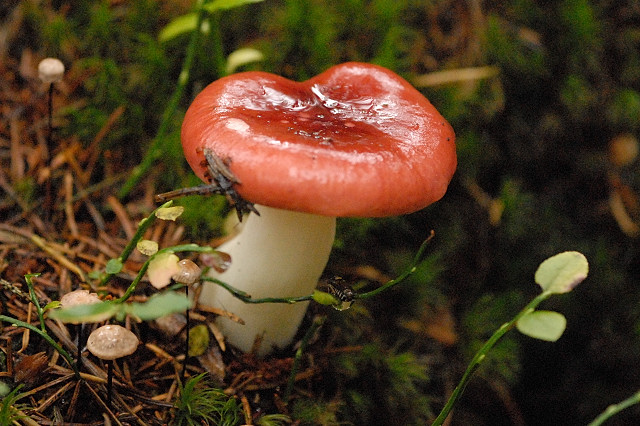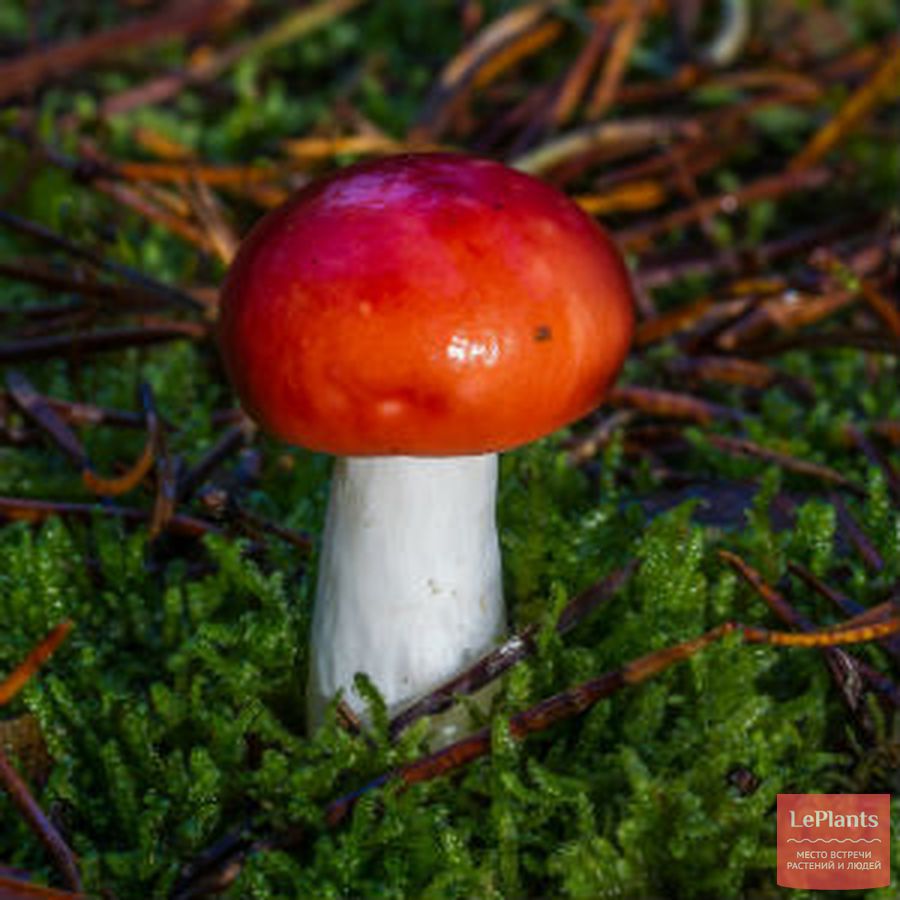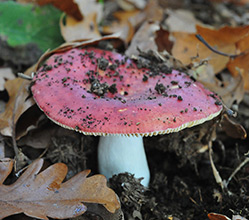Recipes for cooking dishes and preparations
Before cooking, the mushrooms are thoroughly washed, then quickly peeled, prying the skin from the edge, and slightly cutting out the middle. Peeled fruiting bodies are immediately processed, preventing darkening. They are suitable for any preparations and meals, except for the first courses.
Natural russula
Species without bitterness are used - edible russula and green. After initial processing, they are boiled in acidified and salted water at the rate of 40 g of salt and 10 g of citric acid per 2 liters of water. It should be borne in mind that during cooking, they will shrink significantly, decreasing in volume, and at the end of cooking they will sink to the bottom.
After boiling the mushrooms for 20 minutes, they are laid out in jars and poured with boiling broth, after which they are sterilized for at least one and a half hours. The product is then sealed, cooled and stored in a cool place.
Russula in hot salting
This healthy spicy pickle is one of the best mushroom preparations. For 2 kg of mushrooms, you will need 4 tablespoons of salt, 2 bay leaves, 6 black peppercorns, 4 black currant leaves, some cloves and dill seeds.
Pour 1 glass of water into a bowl, add salt and bring to a boil. Mushrooms are immersed in a boiling brine, the foam is removed, after complete boiling, spices are placed and cooked over low heat for 15 minutes. Readiness can be determined by the settling of the pieces to the bottom and brine clarification. The workpiece is cooled and placed in jars, filled with brine and closed. Pickles are ready in a month and a half.
Russula, fried in breadcrumbs
Large caps of species without bitterness are peeled, cut into halves, salted, dipped in an egg, breaded in flour and sprinkled with breadcrumbs. The pieces are fried in a large amount of boiling vegetable oil.
The workpiece is laid out in half-liter jars 1 cm below the neck and sterilized for one hour. Then they are sealed, cooled and stored in a cool place.
Mushroom caviar
Thoroughly washed and cleaned fruit bodies are boiled for 30 minutes, constantly removing the foam, then thrown back on a sieve and placed in a porous canvas bag under oppression for 4 hours to drain excess liquid.
The mushrooms squeezed out in this way are finely chopped or ground in a meat grinder with a large grill together with a small onion head, 50 g of salt per 1 kg of mushrooms and black pepper are added. The resulting caviar is placed in sterile jars, poured with boiled oil and covered with clean dry lids. The food is stored for a short time, about one month, in the refrigerator.
Literature
- Garibova L.V., Sidorova I.I. Mushrooms. Encyclopedia of the Nature of Russia. - M., 1999
- Mushrooms of the USSR. - M., 1980
- Arora, D. (1986). Mushrooms demystified: A comprehensive guide to the fleshy fungi, Berkeley: Ten Speed Press. pp. 83-103
- Funghi - Instituto Geografico De Agostini, Novara, Italia, 1997
- Kibby, G. & Fatto, R. (1990). Keys to the species of Russula in northeastern North America, Somerville, NJ: Kibby-Fatto Enterprises. 70 pp
- Weber, N. S. & Smith, A. H. (1985). A field guide to southern mushrooms, Ann Arbor: U Michigan P. 280 pp
- Moser, M. (1978) Basidiomycetes II: Röhrlinge und Blätterpilze, Gustav Fischer Verlag Stuttgart. English edition: Keys to Agarics and Boleti ... published by Roger Phillips, London
- Partly translated from Dutch page
Description of fiery russula
The cap is rounded, bright red, may be covered with discolored whitish spots. In wet weather, the surface becomes smooth, almost glossy, sticky. The edge of the cap is dull, ribbed, may be covered with small stripes.

The leg is wide, cylindrical, hollow inside, bright white, even, dense. At the base, it may become pink and thicker. In old burning mushrooms, it turns yellow, becomes friable, in places it turns pink. The entire surface of the mushroom leg is covered with a network of shallow grooves.

From the photo you can see that the flesh of the stinging russula is white, dense, elastic, in old mushrooms it can become looser, creamy or pink.
The plates of the burning russula are dense, wide, white, infrequent, and may be bifurcated. The plates are loosely attached to the leg. In old mushrooms, they can become creamy or yellowish, separate from the stem.
The spores of this representative of the russula family are spherical, spiked, white and small.
The pungent russula does not have a characteristic mushroom aroma, sometimes it can give off a subtle fruity smell, but more often without it at all.
Attention! The taste of the pulp is scalding, bitter, pungent, pungent and pungent, which is why, in fact, the species got its name
Edibility, medicinal properties, benefits and possible harm
Among mycologists, there is still a dispute about the edibility of the stinging russula. Some argue that this species is inedible due to the presence of the alkaloid muscarine in it. It can lead to serious disturbances in the functioning of the intestines and stomach. Others call it conditionally edible, refer to the fourth category and recommend using it for food only in salted form after thorough washing and boiling for at least 20 minutes. Foreign experts classify this species as weakly poisonous. In folk medicine, purple and sickening russules are used as an antibacterial agent that helps to cope with abscesses. Mushrooms are rich in vitamins and minerals. They are a source of protein, are low-calorie foods. But do not forget that russula are quite heavy for the stomach and liver, therefore, people with diseased kidneys, gastrointestinal tract, pregnant women, the elderly should limit their consumption.
Interesting Facts
It is known that mushroom dishes appeared in ancient Babylon, ancient Rome and ancient Greece. It was then that they were divided into edible and inedible. Today, some housewives use salt to eliminate the bitter taste of the nauseating russula. Mushrooms are abundantly sprinkled with it, placed in the refrigerator overnight, and carefully boiled the next day.
The color of the cap depends on vitamin D, which the russules themselves produce.
Now there are more than 270 species of mushrooms belonging to the russula family. Many of them are safe, but some can harm the human body. Therefore, knowledge of the signs of the stinging russula will help to accurately distinguish this variety from safe relatives.
Russula fading
| Group: | Lamellar |
|---|---|
| Plates: | White |
| Colour: | Crimson |
| Info: | On the cut turns red |
| Department: | Basidiomycota (Basidiomycetes) |
|---|---|
| Subdivision: | Agaricomycotina (Agaricomycetes) |
| Class: | Agaricomycetes (Agaricomycetes) |
| Subclass: | Incertae sedis (indefinite) |
| Order: | Russulales |
| Family: | Russulaceae (russula) |
| Genus: | Russula (Russula) |
| View: | Russula exalbicans (russula, fading) |
Description
The beautiful russula is characterized by a bright color of the cap, which "fades" over time, hence the name of the species.
Hat
Fading russula caps are usually small (up to 10 cm in diameter), but there are extremely large overripe specimens. The color is usually close to crimson, with darker edges. Enlightenment can be observed in the center. Small russules have spherical, gradually opening caps. The surface of the cap is dry and smooth. With the maturation of the mushroom and an increase in its size, the color of the cap turns pale. The skin is difficult to separate from the cap.
Leg
The leg of a beautiful russula is relatively thick and low (about 3 cm in thickness and 6 cm in length). It is cylindrical in shape with a downward extension. Its color is predominantly white with a pinkish tinge in the upper third. In the lower third, yellow spots may appear.
Pulp
In young specimens, the flesh is white, and in old specimens it is grayish, it turns red on the cut, then turns gray. The consistency is dense, tough, especially at the legs, so many people prefer to eat only hats. The raw mushroom tastes bitter, but when cooked it is sweetish.
Distribution and collection
The beautiful russula is widespread almost all over the world, but prefers temperate latitudes. Symbiotic coexistence is usually found in russules fading with deciduous trees. But the growth of this species is also possible in coniferous forests.
Similar species
The fading russula has a rather characteristic appearance so as not to be confused with other mushrooms. The only mushroom that looks a little like her is the russula, burning or emetic.
The latter is distinguished by whiter plates (not darkening in mature mushrooms) and pulp that does not gray out on the cut. This mushroom has a very bitter taste, therefore it is considered inedible.
Its use can cause stomach troubles, which reflects its name. However, according to some sources, russula emetic becomes edible when boiled well.
Edibility
The beautiful russula has, according to many consumers, very mediocre taste. The legs of these mushrooms are rarely eaten because of their rigidity. We can say that russula is an amateur mushroom, suitable for those who prefer a strong food consistency. After boiling, russula are fried with potatoes, salted and pickled.
Interesting facts
Russula mushrooms, including such as the fading russula, are characterized by a number of interesting properties:
- Russulin contained in russula promotes milk curdling, therefore russula components can be used in cheese making.
- Lecithin, which is part of this mushroom, lowers the content of bad cholesterol in the blood.
- Regular use of russula cleanses the gastrointestinal tract.
- The russula got its name not because it can be eaten raw. Quite the opposite: like any conditionally edible mushroom, it requires preliminary digestion.
And the name comes from the fact that pickles from these mushrooms are prepared faster than from the rest.
Not all mushroom pickers collect russules. Many neglect them, because there are boletus, moss and other, more "valuable" mushrooms. However, fried or salted russula are also quite edible and tasty.
Description
Russula emetica is also known under the alarming names emetic russula, nauseous russula and caustic russula. Some classify it as conditionally edible, while other experts put it on the lists of inedible or weakly poisonous. One thing is certain - the use of this russula in food is associated with a health risk.

The species has the following characteristics:
- a shiny, smooth cap of a bright scarlet color, in the center is darker, sometimes with yellowish, light areas, with a diameter of 3 to 10 cm.In the early stages of growth, it is convex, later acquires a flat shape with a slightly depressed middle and radial grooves along the edges, often cracking. It becomes sticky in wet weather;
- the plates adhered to the pedicle are relatively rare, pure white, they become light cream only in very old specimens;
- disputes are snow-white;
- white, sometimes slightly pink leg has a clavate shape. Its maximum dimensions are 2 cm in thickness, 8 cm in length. Covered with a bloom;
- white pulp on the cut and break does not darken, odorless, has a bitter acrid taste.
Is it possible to eat stinging russula
Burning russula is not recommended to be eaten. The mushroom not only has an unbearably bitter taste, but also causes mild to moderate food poisoning. If a few pieces of pungent russula end up in a basket of edible mushrooms, it will not spoil the taste of the cooked dishes, but it may cause mild stomach upset.
In some sources, the burning mushroom is called conditionally edible and is recommended to be eaten after double boiling, and each time the mushroom broth should be drained to remove the pungent bitterness of the burning russula. After pickling and salting, the mushroom pulp may darken. It should be borne in mind that with repeated use of this conditionally edible burning fungus, toxins accumulate in the body and negatively affect the functioning of the liver and organs of the gastrointestinal tract.
Important! In accordance with the latest research by scientists, it has been proven that a burning russula, when eaten repeatedly, can provoke the growth of cancer cells.
Description and characteristics of the edible mushroom
Its Latin name is Russula vesca, it belongs to the category of edible mushrooms of the russula family of the russula genus. Another name is edible russula.
The hat is hemispherical, with a diameter of 5 to 11 cm, sometimes there are specimens with a large size. It is fleshy, almost always cracked. Depending on the age of the fungus, its shape also changes. In older specimens, it is more flattened. The edge of the cap is wavy-curved or ribbed. The color scheme is varied: red, light pink, beige, greenish brown, very rarely has a completely white color.
The russula hymenophore is the lower part of the cap containing the spore-bearing layer (hymenium). It affects the development of spores.
To check its condition, you need to pay attention to the density of the plates. The closer they are to each other, the fresher and healthier the mushroom.
The plates are snowy, sometimes creamy.
The flesh on the cut is dense, white. The taste is pleasant, vaguely reminiscent of a nut. Virtually odorless, however, ripe pulp can give off a herring aroma.
The leg is cylindrical, tapering upwards. It reaches a height of 30–65 mm, and its thickness is 15–25 mm. The color is white, at the very base it has a yellowish or brown tint.
A bit of history
Mushrooms have always been valued in Russia and therefore have earned their place of honor in the diet. They began to actively collect them in the 18th-19th centuries, as it turned out to be an excellent alternative to meat. Russula began to be used often after the Civil War, in the twentieth century. They got their name not because they can be eaten raw (although many people already use them), but because they require minimal processing during cooking, unlike other types of mushrooms. They are distributed all over the world. They can be found in Asia, Europe and America. Nowadays, Russula vesca is very much appreciated, since every year they become less and less due to deforestation.
Symptoms of poisoning with stinging russules and first aid.
When these russules are consumed, food poisoning occurs, which is why they are called emetics. In the composition of these mushrooms there are poisonous substances that disrupt the work of the stomach.

A person begins to experience a pressing feeling in the area of the right hypochondrium and a sharp pain in the intestines 2.5 hours after the use of nauseous russules. With a mild degree of poisoning, diarrhea occurs, in which there is a lot of bile, which is why the russula was called bile.
In more severe cases of poisoning, vomiting opens, muscle pain occurs and general malaise appears. With repeated vomiting and diarrhea, medical attention is needed. In the course of treatment, the stomach is washed and a special diet is prescribed.
Related species of stinging russula.
Buffy russula is a conditionally edible relative of the stinging russula. The shape of its cap can be hemispherical, outstretched and slightly depressed. Its surface is matte, in wet weather it becomes covered with a small layer of mucus. The color of the cap is yellowish ocher. Its leg is long and thin, dense in structure, slightly wrinkled, white or yellow in color. The pulp is dense, but fragile, its taste is rather pungent, and there is no smell.

Collected ocher russula from August to October. Their favorite places of growth are coniferous forests. The ocher russula settle in places with a good level of humidity. In the south of the country, this species is quite rare.
Turkish russula is an edible relative of the emetic russula. The shape of its cap is initially convex, and later becomes flattened. The color of the cap is lilac or violet-brown. The surface of the cap is covered with a slippery skin that can be easily removed. The stem is cylindrical or clavate.The color of the leg is most often white, sometimes pinkish or yellowish. Its pulp is dense with a sweetish taste and a well-defined pleasant smell.
The growing places of Turkish russula are the coniferous forests of Europe. These mushrooms live under spruce and fir trees. They bear fruit in small groups or singly.
Pungent russula: poisonous or edible mushroom?

Pungent russula is a mushroom of the russula family. It is also known as caustic russula, nauseous russula, bilious russula and emetic russula. It is an inedible mushroom.
The Latin name for the mushroom is Russula emetica.
Description of the russula stinging
In appearance, the nauseating russula is very similar to the ordinary russula. But the inedible russula has a very dense structure. The color of her cap is purplish pink or bright red, with a darker center. With age, the color remains unchanged. The surface of the cap is glossy and sticky. The skin is easily separated from the cap.
The shape of the cap of the stinging russula at a young age is convex, while the edges are tightly pressed against the leg, but with age, the cap becomes like a saucer. In adult specimens, the diameter of the caps reaches 11 centimeters. If the cap is too large, it begins to crack.
Pungent russula is a lamellar mushroom. The plates are quite strong, they are located very often. The shape of the plates is correct, the length is the same, and the edges are sharp. They are tightly attached to the cap and stem. The color of the plates is pure white.
The leg of the stinging russula is very fragile. The color of the leg is white, even a dark shade does not appear on the cut. Its length in adulthood reaches 9 centimeters, and the girth reaches 2 centimeters. The pulp in the leg is firm and thin. In old age, it becomes loose. The pulp has almost no smell.
Growing zone of stinging russula
Bile russules are common throughout Russia. These mushrooms most often settle in shady, damp places. In the Far East, stinging russula, as a rule, grow among firs, spruces and cedars. Also, these mushrooms grow in mountain zones. Often, emetic russules are found on the outskirts of peat bogs.
Caustic russules most often grow alone, sometimes they can be found in few groups. They prefer places with acidic moist soil rich in various organic substances. Often, bile russules live in a company with edible russules. Fruiting occurs from July to the end of October.
Evaluation of the edibility of the scorching russula
Many mycologists classify russula emetic to conditionally edible mushrooms, and assure that they are such because of their low taste.
But recent studies have shown that with repeated use of russula, the stinging ones lead to serious disruptions in the functioning of the stomach and intestines, they are not for nothing called vomiting and nauseous.
In addition, burning russules are dangerous in that they can cause the growth of cancer cells.
It is worth noting that a couple of bile russules caught by edible russules will not spoil the taste of the dish and will not cause poisoning.
Symptoms of poisoning with stinging russules and first aid
When these russules are consumed, food poisoning occurs, which is why they are called emetics. In the composition of these mushrooms there are poisonous substances that disrupt the work of the stomach.
A person begins to experience a pressing feeling in the area of the right hypochondrium and a sharp pain in the intestines 2.5 hours after the use of nauseous russules. With a mild degree of poisoning, diarrhea occurs, in which there is a lot of bile, which is why the russula was called bile.
In more severe cases of poisoning, vomiting opens, muscle pain occurs and general malaise appears. With repeated vomiting and diarrhea, medical attention is needed. In the course of treatment, the stomach is washed and a special diet is prescribed.
Related species of stinging russula
Buffy russula is a conditionally edible relative of the stinging russula. The shape of its cap can be hemispherical, outstretched and slightly depressed.
Its surface is matte, in wet weather it becomes covered with a small layer of mucus. The color of the cap is yellowish ocher. Its leg is long and thin, dense in structure, slightly wrinkled, white or yellow in color.
The pulp is dense, but fragile, its taste is rather pungent, and there is no smell.
Collected ocher russula from August to October. Their favorite places of growth are coniferous forests. The ocher russula settle in places with a good level of humidity. In the south of the country, this species is quite rare.
The surface of the cap is covered with a slippery skin that can be easily removed. The stem is cylindrical or clavate. The color of the leg is most often white, sometimes pinkish or yellowish.
Its pulp is dense with a sweetish taste and a well-defined pleasant smell.
The growing places of Turkish russula are the coniferous forests of Europe. These mushrooms live under spruce and fir trees. They bear fruit in small groups or singly.
Russula golden - description, where it grows, the toxicity of the mushroom
It is worth noting an interesting fact that the fruit bodies in question are one of the most popular mushrooms. Russula are common all over the world. In addition, such specimens are very easy to assemble. Due to the bright and memorable color, such fruits can be found without problems in wooded areas. Almost all representatives of this species have a pleasant taste and aroma. Therefore, they are highly valued in the culinary world.
Description
- Fruiting bodies may have a cap no more than 12 cm in diameter. If we take into account young specimens, then they have a convex shape. Only over time does the cap become open. You can often see a depression in the center. The edges become ribbed.
- The surface of young fruiting bodies is glossy and smooth. You may also notice that it is covered in mucus. The color of the cap is almost always brick red. Older fruits have a matte and velvety surface. Their color is often ocher-yellow or orange with reddish spots.
- As for the general structure of the fruiting body, the pulp is crumbly and brittle. In most cases, it has a whitish tint. At the same time, after cutting the mushrooms, the color does not change in any way. Under the cap there are frequent plates that fit tightly to the leg. They are rounded to the edges of the cap.
Spreading
- The fruit bodies in question often grow in forests with old oaks, beech, hazelnuts, spruces and aspens. Linden, elm and similar broadleaf trees can also be found in such woodlands.
- In most cases, such specimens prefer to choose calcareous soil. The fruiting season is mid-summer. It ends in the middle of autumn. Instances can be found singly or in small groups.
Virulence
Mushrooms are edible. However, such specimens, in comparison with relatives, cannot boast of high taste and a bright rich mushroom aroma. This applies to raw fruits. When cooked, mushrooms acquire a completely different, rather good taste and aroma.
Similar species
- The morse russula is similar to the fruit bodies under discussion. Such an instance belongs to edible mushrooms. The hat of such a russula in diameter can reach up to 12 cm. Separately, it is worth noting the fact that in young fruiting bodies, the cap looks like a ball.
- Over time, it takes on the shape of a bell. Old fruiting bodies can already be seen with a flat cap. There is also an old skin on it, while it separates from the pulp without any problems. The hat is often yellow-brown. The leg has a dense structure and a white color. It is rare to see spots on it.
- In most cases, the legs of such mushrooms are almost even, only sometimes they thicken closer to the ground.These russula can often be found in Russian forests. It is this type of fruiting bodies that account for about 48% of all other fruits.
- In most cases, mushrooms are salted. The problem is that they taste rather bitter. Therefore, before salting them, it is imperative to soak them and get rid of the skin from the cap.
- There is also another species that is similar to our mushrooms. The fragile russula is considered a conditionally edible fruiting body. It is small in size. The diameter of its cap can be up to a maximum of 6 cm. Most often it is painted in a pinkish-purple hue. In young specimens, the cap is initially convex.
Golden russules are quite common all over the world. As for the collection of such fruiting bodies, then you should not have any problems with this. The distribution of these copies is quite extensive. After cooking, the mushrooms acquire excellent taste and pleasant aroma.






